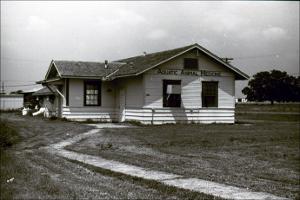| dc.coverage.spatial | College Station, Texas | en |
| dc.date.accessioned | 2018-10-04T20:09:58Z | |
| dc.date.available | 2018-10-04T20:09:58Z | |
| dc.identifier.other | 1364 | |
| dc.identifier.uri | https://hdl.handle.net/1969.1/170922 | |
| dc.description | Image of an Aquatic Animal Medicine building. During the fiscal year of 1970-71, the Department of Veterinary Microbiology had an existing building on the research farm remodeled, furnished and equipped to provide a facility for teaching and research in aquatic animal medicine. A new research project on catfish diseases was initiated during the 1973-74 fiscal year by Veterinary Microbiology. Physical description: black-and-white negatives, 2.5X3.5mm | en |
| dc.description.abstract | The history of aquatic animal medicine at Texas A&M was first formally initiated with the beginning of the Sea Grant Program on the campus in 1968. At that time, the call went out for individuals interested in conducting research on the marine environment and its inhabitants to meet in what is now referred to as the Jack K. Williams Building.
Present were several members of the Wildlife Fisheries Science Department, Department of Oceanography and Dr. Donald Lewis, representing the Department of Veterinary Microbiology and the College of Veterinary Medicine. The vision of Dr.John Calhoun, principal investigator of the institutional proposal, was for sea grant to assume a role similar to that of the land grant concept. Dr. Fred Maurer, Associate Dean of Research for the CVM, suggested that the college prepare a proposal to be submitted as part of the institutional Sea Grant proposal. All areas in the basic sciences, i.e. veterinary anatomy (Dr. Ray Sis), veterinary public health (Dr. Archie Flowers), veterinary parasitology (Dr. Buddy Faries), veterinary physiology & pharmacology (Dr. Bennie Camp), veterinary pathology (Dr.Raymond Bendele) and veterinary microbiology (Dr. Don Lewis) enthusiastically responded. The proposal was submitted, accepted, and the National Office of Sea Grant in its written review, indicated that the application of the College of Veterinary Medicine was "one of the strongest applications nationwide." In a subsequent site visit review, several programs were eliminated, but Texas A&M University was commended for its leadership and involvement of the veterinary medicine component in its application. | en |
| dc.relation.ispartof | College of Veterinary Medicine Image Collection | en |
| dc.rights | "It is the user's responsibility to secure permission from the copyright holders for publication or re-use of any materials. Permission must be obtained in writing prior to publication. Please contact the Medical Sciences Library for further information." | en |
| dc.subject | Marine ecosystem health | en |
| dc.subject | Veterinary Microbiology | en |
| dc.subject | Veterinary Parasitology | en |
| dc.subject | Veterinary Anatomy | en |
| dc.subject | Gulfs--Texas | en |
| dc.subject | College buildings | en |
| dc.subject | Aquatic Animal Medicine | en |
| dc.subject.mesh | Aquatic Organisms | en |
| dc.subject.mesh | Marine Ecology | en |
| dc.subject.mesh | Biology, Marine | en |
| dc.subject.mesh | Catfishes | en |
| dc.subject.mesh | Fish Diseases | en |
| dc.subject.mesh | Fishes | en |
| dc.subject.mesh | Oceans and Seas | en |
| dc.subject.mesh | Seafood | en |
| dc.title | Aquatic Animal Medicine Building, number 2 | en |
| dc.contributor.sponsor | College of Veterinary Medicine & Biomedical Sciences | |
| dc.type.material | Image | en |


